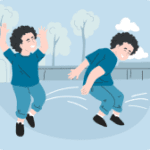- Home
- Read
SPD
Sensory diets are systematic and individualized strategies that help modify or meet sensory needs, particularly benefiting children and adults with
Autumn brings an exciting opportunity to celebrate this colorful season with activities tailored for children with varying sensory profiles. Whether
Parents, educators, and therapists often face a perplexing challenge when trying to distinguish between Sensory Processing Disorder (SPD) and Attention
ADHD
Sensory diets are systematic and individualized strategies that help modify or meet sensory needs, particularly benefiting children and adults with
25 Sensory Activities and Exercises for Kids with Sensory Processing Disorder and ADHD If your child has Sensory Processing Disorder
Children with Attention-deficit/hyperactivity disorder (ADHD) and Autism Spectrum Disorders (ASD) face difficulties in regulating their emotions and sensory input from
Autism
Sensory diets are systematic and individualized strategies that help modify or meet sensory needs, particularly benefiting children and adults with
“It takes a village to raise a child. It takes a child with autism to raise the consciousness of the
Dealing with autism meltdowns can be a challenging experience for caregivers, teachers, and those on the spectrum alike. A meltdown
Social Anxiety
Have you or a loved one received a diagnosis and now are having a long wait time to find answers
Navigating the complex world of special needs parenting can be likened to solving a jigsaw puzzle where the pieces come
The role of a behavioral interventionist (BI) in the field of child development and special education is integral, yet it
Join thousands of parents and educators each week
Because staying in the loop is important
Subscribe to Our Newsletter
- Learn by Diagnosis
- ADHD
- Asperger’s Syndrome
- Atypical Autism
- Auditory Processing Disorder (APD)
- Autism Spectrum Disorder (ASD)
- Dyslexia
- Delayed Speech
- Childhood Disintegrative Disorder (CDD)
- Conduct Disorder (CD)
- Developmental Dyslexia
- Dyscalculia
- Dysgraphia
- Giftedness
- High-Functioning Autism (HFA)
- Language Disorders
- Language Processing Disorder
- Learning Disabilities (LD)
- Low-Functioning Autism (LFA)
- Mood Disorders
- Nonverbal Learning Disorder
- Oppositional Defiant Disorder
- Pervasive Developmental Disorder – Not Otherwise Specified (PDD-NOS)
- Seizure Disorders
- Sensory Discrimination Disorder
- Sensory Modulation Disorder
- Sensory Over-Responsivity
- Sensory Processing Disorder – Not Otherwise Specified
- Sensory Processing/Integration Disorder
- Sensory Seeking/Craving
- Sensory Under-Responsivity
- Sensory-Based Motor Disorder
- Sleep Disorders
- Social Anxiety
- Specific Learning Disorder with Impairment in Reading
- Substance Use Disorders (SUD)
- Tourette Syndrome
- Visual Processing Disorder (VPD)
- Affiliates
- Find a Therapist
- Company











 Speech Therapy
Speech Therapy Physical Therapy
Physical Therapy Occupational Therapy
Occupational Therapy

